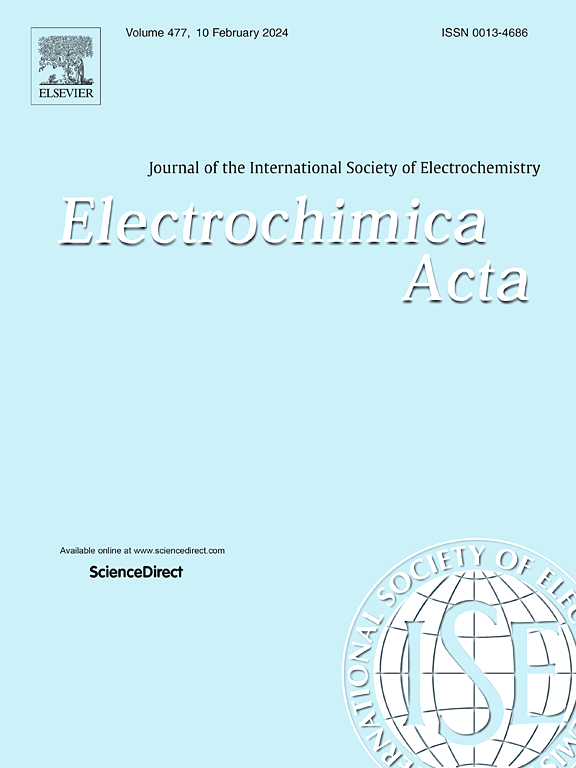含功能化吡啶基苯并噻唑和碳(硫)酰胺的铜螯合物电催化析氢,其配位模式为κ3-SNS、ONS、SNN或ONN
IF 5.5
3区 材料科学
Q1 ELECTROCHEMISTRY
引用次数: 0
摘要
以乙酸和三氟乙酸为质子源,研究了6种κ3-SNS、ONS、SNN或ONN配位模式的铜螯合物作为二甲基甲酰胺析氢反应(HER)的电催化剂。通式[Cu(Ln)(OAc)]•zH2O (z = 0-3)和Ln = 的铜(II)配合物:双-N-(4-氯苯基)吡啶-2,6-二碳硫酰胺(L1),双-N-(2,5-二甲氧基苯基)吡啶-2,6-(2,5-二甲氧基苯基)氨基吡啶-2-碳硫酰胺(L2), N-(2,5-二甲氧基苯基)氨基吡啶-2-碳硫酰胺(L3), 6-(6-氯-1,3-苯并噻唑-2-基)-N-(4-氯苯基)吡啶-2-碳硫酰胺(L4),用Ln在乙醇中回流Cu(OAc)2•H2O制备了6-(4,7-二甲氧基-2-苯并噻唑基)- n -(2,5-二甲氧基-2-苯并噻唑基)- n -(2,5-二甲氧基-2-苯并噻唑基)-2-吡啶碳硫酰胺(L6)。具有κ3-SNS配位模式的铜配合物表现出最高的催化增强和法拉第效率。结果还表明,甲氧基取代基略优于氯取代基。醋酸中Cu(II)配合物的法拉第产率为77 ~ 97%,过电位在0.69 ~ 0.83 V之间。当三氟乙酸作为质子源时,在法拉第产率为86 ~ 98%的情况下,获得了0.57 ~ 0.73 V的过电位。从波脚分析(FOWA)图中提取速率常数,其中提出了EECC催化生成H2的机制。本文章由计算机程序翻译,如有差异,请以英文原文为准。
Electrocatalytic hydrogen evolution with copper(II) pincer complexes bearing functionalized pyridyl benzothiazoles and carbo(thio)amides of a κ3-SNS, ONS, SNN or ONN coordination mode
Six copper(II) pincer complexes of κ3-SNS, ONS, SNN or ONN coordination modes were investigated as electrocatalysts for the hydrogen evolution reaction (HER) in dimethylformamide using acetic acid and trifluoroacetic acid as proton sources. The copper(II) complexes of general formula [Cu(Ln)(OAc)]•zH2O (z = 0-3) and Ln = bis-N-(4-chlorophenyl)pyridine-2,6-dicarbothioamide (L1), bis-N-(2,5-dimethoxyphenyl)pyridine-2,6-dicarbothioamide (L2), N-(2,5-dimethoxyphenyl)-6-[(2,5-dimethoxyphenyl)carbamothioyl]pyridine-2-carboxamide (L3), 6-(6-chloro-1,3-benzothiazol-2-yl)-N-(4-chlorophenyl)pyridine-2-carbothioamide (L4), 6-(4,7-dimethoxy-2-benzothiazoyl)-N-(2,5-dimethoxyphenyl)-pyridinecarboxamide (L5) and 6-(4,7-dimethoxy-2-benzothiazolyl)-N-(2,5-dimethoxyphenyl)-2-pyridinecarbothioamide (L6), were prepared by refluxing Cu(OAc)2•H2O with Ln in ethanol. The copper complexes with the κ3-SNS coordination mode showed the highest catalytic enhancement and Faradaic efficiencies. The results also suggested that the methoxy substituents were slightly advantageous to the chloro substituent. Moderate overpotentials between 0.69 and 0.83 V at Faradaic yields between 77 and 97% were obtained for the Cu(II) complexes in acetic acid. Lower overpotentials within the range of 0.57 and 0.73 V were obtained at Faradaic yields between 86 and 98% when trifluoroacetic acid was used as the proton source. Rate constants were extracted from foot-of-the-wave analysis (FOWA) plots where an EECC mechanism is proposed for the catalytic formation of H2.
求助全文
通过发布文献求助,成功后即可免费获取论文全文。
去求助
来源期刊

Electrochimica Acta
工程技术-电化学
CiteScore
11.30
自引率
6.10%
发文量
1634
审稿时长
41 days
期刊介绍:
Electrochimica Acta is an international journal. It is intended for the publication of both original work and reviews in the field of electrochemistry. Electrochemistry should be interpreted to mean any of the research fields covered by the Divisions of the International Society of Electrochemistry listed below, as well as emerging scientific domains covered by ISE New Topics Committee.
 求助内容:
求助内容: 应助结果提醒方式:
应助结果提醒方式:


